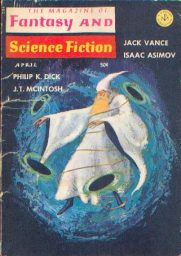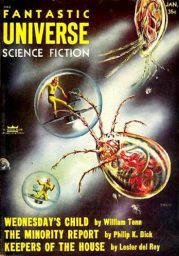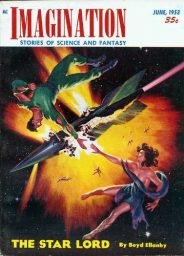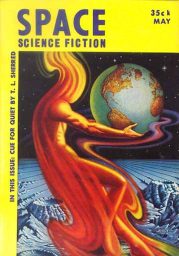We now come to the last four stories in The Philip K. Dick Reader. These are also stories all made into movies.

“We Can Remember It For You Wholesale” (F&SF April 1966): The story that became the movie Total Recall. Douglas Quail is an office worker with an obsession of going to Mars. The wife is not enthused. He decides to have the memories of fake vacation implanted by a company called Rekal. Things go wrong during the procedure where Quail recovers his memory that he is a secret agent who has returned from Mars. Sent home, he is not sure what is going on. The wife leaves him and then two uniformed men enter with guns drawn. His memories return that he assassinated a political agitator on Mars. There is a thought transmitter inside Quail’s brain that allows his former commander to contact him. Quail gives up and accedes to psychiatric evaluation. There is another ripple as a childhood fantasy that he prevented an alien invasion is true. Wheels within wheels. Total Recall deviates using the first part of the story as a futuristic action spectacle for Arnold Schwarzenegger.

“The Minority Report” (Fantastic Universe, January 1956): Crime has been eliminated in the future by using mutants wired into a computer. The mutants create crime predictions. The police then arrest the person before the crime. John Anderton is the chief and founder of the PreCrime Division. A report predicts he is to murder someone he does not know in the future. Then begins a cat and mouse chase story. He finds there is “minority report” wherein the three mutants do not agree. The Army is out to discredit PreCrime using the minority report at a rally. Anderton shoots General Kaplan killing him rather than allow PreCrime to be discredited. The last part of the story is Anderton explaining to his successor on why he followed the path he did. All three reports differed, Anderton decided on the third course to prevent a military takeover and martial law. Anderton and his wife leave for another planet at the end. I have not seen the movie. I avoid Tom Cruise and Steven Spielberg whenever possible. The story has the A. E. van Vogt influence. The story originally appeared in Fantastic Universe, a magazine with a reputation of being decidedly second tier if not third tier.

“Paycheck” (Imagination, June 1953): Philip K. Dick wrote regarding the story in The Best of Philip K. Dick:
“In this story I got to thinking that there are times in our lives when having a dime to make a phone call spells the difference between life and death.”
Jennings, an electric engineer, collect his pay for a two year project for the Rethrick Corporation. Part of the contract is his memory of his employment is erased. His pay: a piece of fine wire, a bus token, a ticket stub, a green strip of cloth, a code key, half a broken poker chip, a parcel receipt.
Security Police pick him demanding to know what Rethrick is up to. Jennings escapes using the wire. He uses each item to help him along as he finds he worked on a machine that allow people to view the future. Jennings in the past knew he would be in trouble in the police state of the U.S., so he left the items for his future self along. Jennings eventually blackmails Rethrick into taking him along as a partner. This story is breezy in tone than most stories in the book. Jennings has a slightly likeable roguish nature that makes the story less oppressive in mood than most Dick stories.
Again, I have not seen the movie.

“Second Variety” (Space Science Fiction, May 1953): This was the inspiration for the movie Screamers. This is full blown depressing Philip K. Dick. The Soviet Union almost conquered the U.S. There has been nuclear war. The landscape is mostly blasted dust and sand. The U.S. counters using robots called “claws” to kill Soviets. There is a problem, the claws are becoming sentient. They are making ever more sophisticated machines including those that pass for human. Is it human? A recurring plot with Philip K. Dick. The Soviets ask for a conference to make peace. The American officer crosses no-man’s land with some adventures of claw attacks. The Soviets have found there are four varieties of human like robots. They have not identified the “second variety,” hence the title. The story is a trip into paranoia attempting to determine who might be the second variety. This story might have been an influence on Galactica 80 and the Battlestar Galactica reboot where humans could not who might be a Cylon. Fred Saberhagen’s “Berserker” series might also been inspired by “Second Variety.”
Philip K. Dick has been popular for film adaptation. His stories are often refitted as more cyberpunk than 1950s Cold War paranoia. The movies also have a lot more action that your average Philip K. Dick story. I noted the influence of A. E. van Vogt in the stories “The Minority Report” and “Paycheck.” You would think screenwriters would investigate van Vogt for adaptation. I have to say that reading The Philip K. Dick Reader was not a pleasant experience. His stories just don’t push the right buttons for me the way H. Beam Piper or Poul Anderson would. There is no sense of wonder, there is little joy. I remember reading somewhere that we are living the future of science fiction, unfortunately we are in the future of Philip K. Dick. At least we are not in post-nuclear war radioactive dust which permeates his fiction.
Philip K. Dick was everywhere in lower level science fiction magazines in the 1950s. He was not in Galaxy or Astounding very much. Instead he was in Imagination, Space Science Fiction, etc. His ideas continued in his novels as we shall see next week.
Please give us your valuable comment